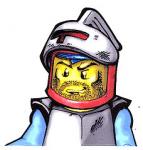Conversion of St. Paul by Francesco Mazzola

The Conversion of St. Paul, possibly commissioned by a Bolognese doctor (Parmigianino had fled to Bologna to escape the sack of Rome), is a bravura work whose violently asymmetrical composition, with its unique, tilted horizon, makes visible the inner upheaval Saul must have experienced upon hearing the voice of Christ whom he had been persecuting. Parmigianino shows his world being turned upside down.
Saul, having fallen from his horse, lies sprawled on the ground, his blinded eyes dazzled by the divine light. The horse, with its disproportionally small head, rears up above him. Saul’s outstretched limbs set up powerful zig-zagging diagonals for the eye to follow onto the horse’s body. The dynamic poses of the figures are awkward and untenable: The horse must either continue to rear up even higher or quickly drop its hooves back to the ground.
But the horse only appears to be rearing up: A comparison of the angle of its body with that of the horizon reveals that the two are actually parallel, so it must be the ground that is falling away beneath the horse’s feet. A close inspection at the background reveals further spatial distortions: The landscape seems to warp and melt below the angle of the horizon, leveling itself out just to the right of Saul’s jutting knee; the small figures and animals there stand aligned with the vertical side of the painting. The clouds in the sky too are strangely horizontal from our point of view. Nothing here is as it seems.
The biblical account, of course, makes no mention of a horse; the tradition of depicting the episode as an equestrian scene dates from the 12th century. But the image of the fallen rider has important symbolic meaning. A rider on a horse represents man in control of nature, or the spiritual man in control of his own fleshly nature. Thus, a man thrown by his horse is a man no longer in control of himself. Saul is becoming Paul, the slave of Christ, and his sword, a symbol of power and one of Paul’s pictorial attributes, lies useless on the ground. (Michael Schrauzer, This Rock)





1 comment:
Good discussion of the symbolism. I'd never thought of that: I'd always pictured Paul riding a horse too, apparently because that tradition was passed on to me in my early religious schooling.
Post a Comment